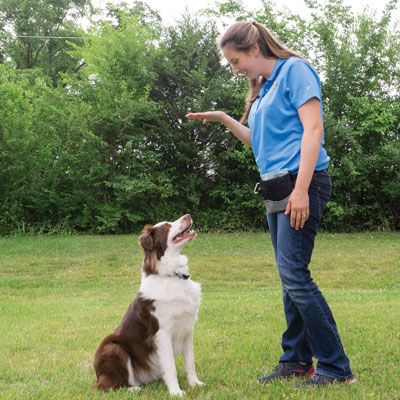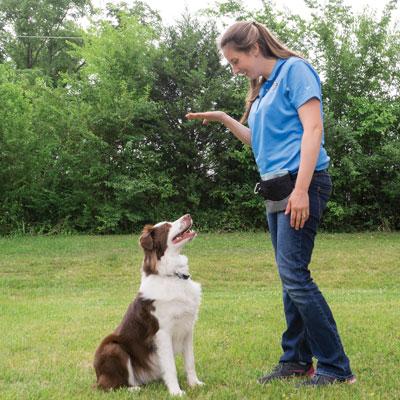January is National Train Your Dog month. You don't need to be a behaviorist or training whiz to teach your dog the basics. In fact, there are some things that every dog should know for safety reasons, your peace of mind, and basic canine manners. Here's how to teach three important doggy skills.
TEACHING COME
Teaching your dog to come--a recall command--is important for safety, and helps prevent door dashing, running into traffic, or impolite behavior. Make the action something your dog wants to do naturally, and you'll set your pet up for success. Here's how.
- Find out what your dog loves most as a reward. That might be a treat, a toy, or just fun attention. Choose a time without distractions so your dog's attention focusses easily on you. Then call his name and show him the reward.
- As soon as your dog notices you and the squeaky or treat, say firmly, "Name, COME." You want to use his name, and the action-command with consistency so your dog associates his name and the word with the specific request.
- As soon as he looks at you, turn and race away in the opposite direction. Yes, I know this makes no sense at first--but it builds on the dog's natural inclination to chase and play. Dogs rarely can resist the invitation, especially knowing you've got yummies or the squeaky as a lure.
- Allow your dog to catch up, and as soon as he does give him the reward. Praise him so he knows how smart he is and you're happy with him. Repeat the game two or three times, encouraging your dog to chase you again and again, and practice the chase-come game a couple of times a day for the first week. Stop before he gets tired--you want the dog to be successful and excited, and not get bored and ignore the game.
- With repetition, your dog will learn to associate the COME command with fun rewards like attention. No matter how long it takes, praise your dog any time he finally does come to you. Make sure he has positive experiences with the recall, so he never fears returning to you.
TEACHING SIT
 Teaching dogs to "sit" on command can be used as a way for dogs to ask for and get all good things in life. Consider the canine "sit" to be the dog's way to say "please" and "thanks." You can use lure training (a treat or toy) to explain to your dog what's expected. Here's how.
Teaching dogs to "sit" on command can be used as a way for dogs to ask for and get all good things in life. Consider the canine "sit" to be the dog's way to say "please" and "thanks." You can use lure training (a treat or toy) to explain to your dog what's expected. Here's how.
- Stand before your dog and say the command SIT in a clear, firm tone. At the same time, hold the lure slightly over his head and in front of his nose, and lift the lure over the top of his head. To follow the toy or treat, he must lift his nose, so he must SIT to keep from losing his balance.
- As soon as his tail hits the ground, reward your dog with the treat or toy.
- Repeat the exercise several times each day, until your dog learns what SIT means and anticipates by sitting before you even show him the lure. Bravo, what a smart dog!
- By teaching your dog to sit on command, your dog will figure out lots of ways to "ask" for different things, like treats or open doors or playtime.
TEACHING WAIT
The STAY command can be a challenge to teach dogs, because there are always distractions that tempt them to do the opposite. But teaching WAIT can be done easily, and is a great tool all dogs should be taught. An effective and quick way to teach this command is to use the door as a training tool. You won't need any sort of reward, either. Getting to go through the door rewards the dog better than any treat or toy. Here's how it works.
- Approach the door, and when your dog follows you, tell him "wait."
- Put a hand on the door handle, but open only a crack. Don't allow the dog to go through the door, even if he's pushing between you and the opening.
- As he tries to beat you out the door, tell him WHOOPS or something similar, and close the door. It should be the dog's behavior that makes the door shut.
- Wait until he makes eye contact and repeat the "wait" command as you again grab the door handle. Any movement forward should trigger you to pull your hand away once again and say WHOOPS!
- Try again, but any movement forward means you shut the door and he can't go through. Only continue to open the door as long as the dog stays still. You may wish to include a polite "SIT" as his request. Dogs learn that THEY control the doorway opening very quickly.
- A three to five-second WAIT is a good start. Then say GOOD DOG and open the door so he can sprint outside as his reward. Remember to choose your commands with care and use the same words each time so the consistency helps him learn what "wait" and WHOOPS mean.
Practice at different doors, from car doors and baby gates, to front and back doorways, so he understands the WAIT command applies all the time. Teaching this behavior helps create a polite dog for a variety of circumstances.


